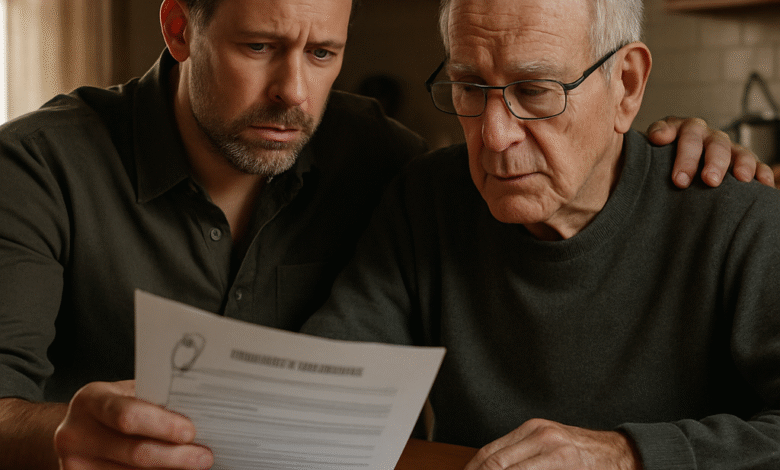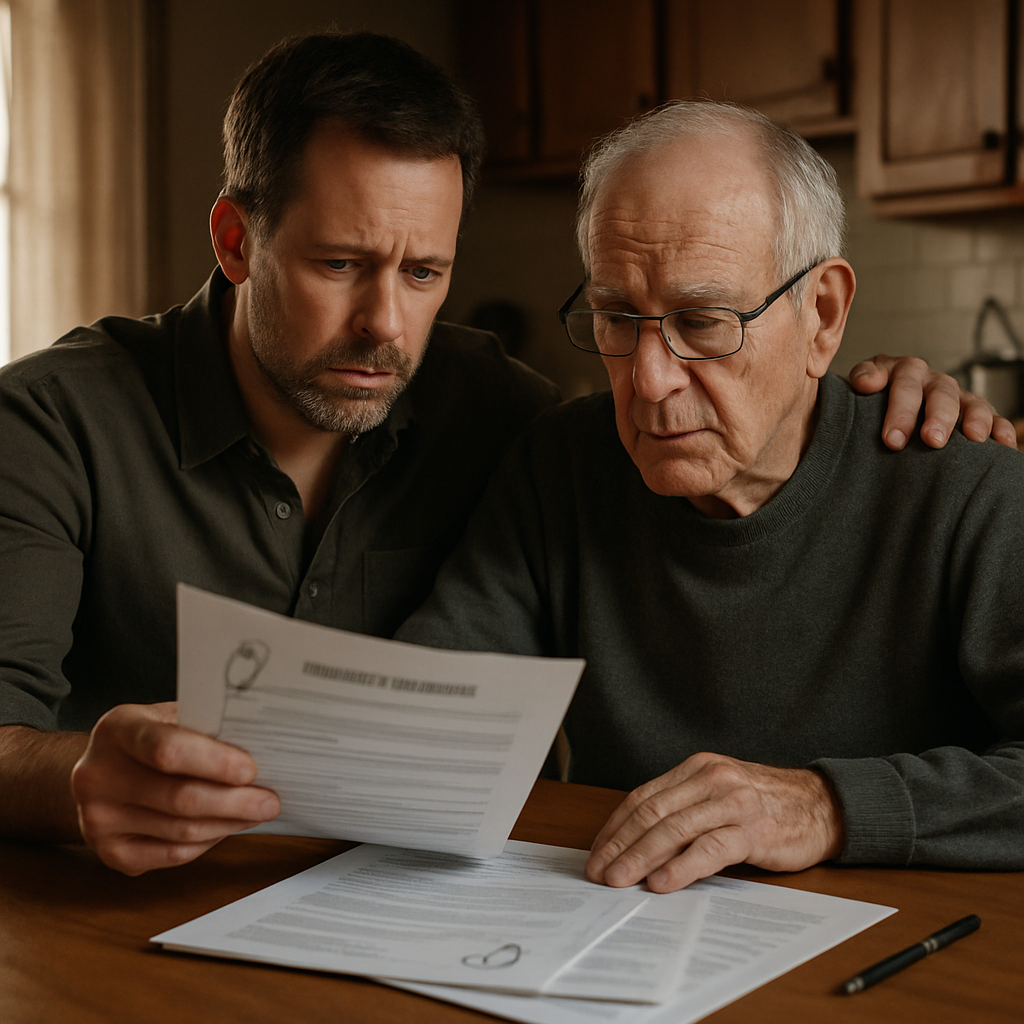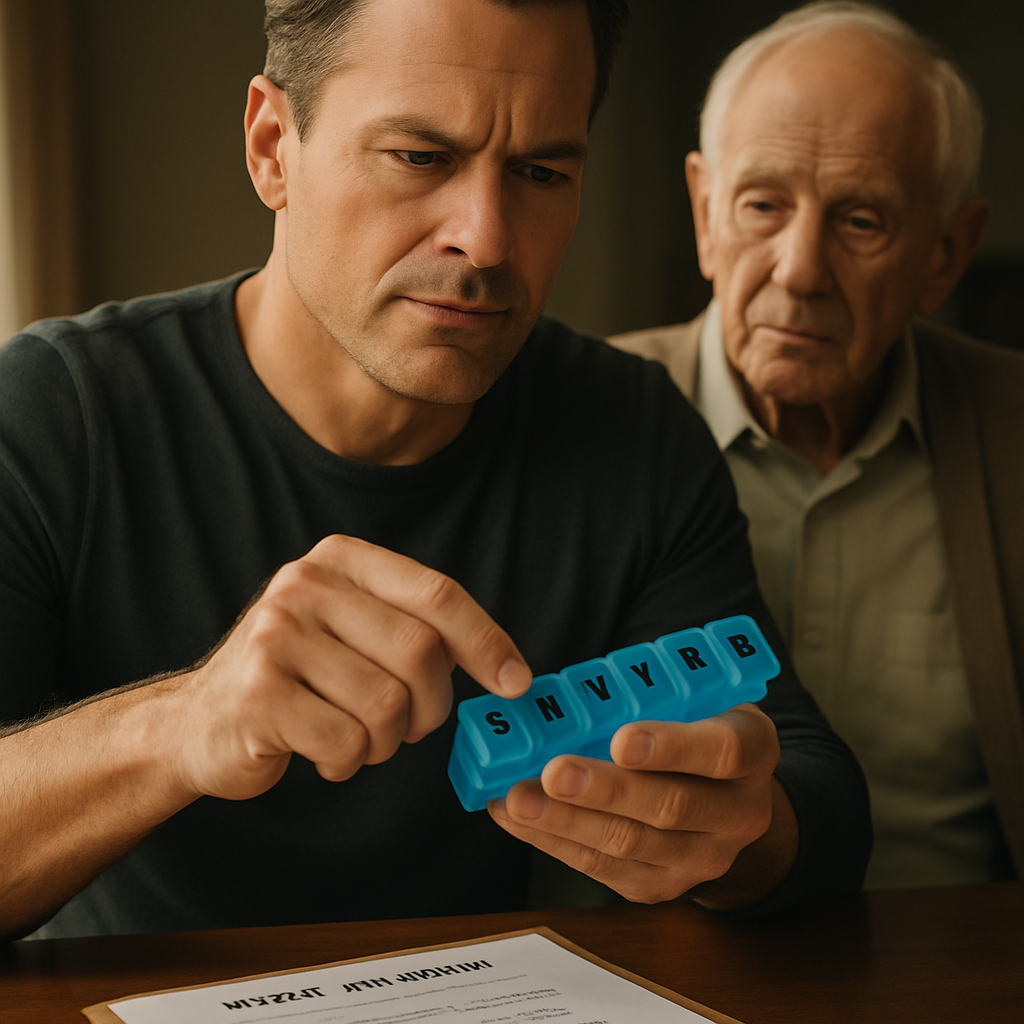Caring for Aging Parents Checklist: Practical Steps for Middle-Aged Men

There’s no easy way to say this: caring for aging parents is one of those midlife curveballs that sneaks up and demands your full attention. You might be juggling career peaks, kids heading into their own wild rides, and suddenly, your folks need more than just a phone call.
It’s overwhelming, isn’t it? That tug-of-war between wanting to be there for them and still keeping your own life—and sanity, honestly—intact. You’re not alone in that tight spot.
Think about it this way: you’ve planned for everything else in life with a checklist—workouts, finances, even your wardrobe staples—but what about a solid game plan for supporting your parents as they age? That’s where a caring for aging parents checklist really becomes a lifesaver.
Why now? Because midlife is the stage where these responsibilities usually stack up. Health changes, medical appointments, home safety upgrades, legal stuff—it all piles on. And without a clear roadmap, it’s easy to feel burnt out or miss something critical.
But don’t sweat it; this is exactly why we’re diving deep into a practical checklist tailored for guys like us. You’re going to find steps that cut through the noise, helping you handle this chapter with confidence and maybe even some peace of mind.
Already wondering where to start or how to balance it all without losing your edge? Stick with me here, because there’s a way to get ahead of the chaos. Let’s break it down and make this feel doable, not daunting.
If you want a sneak peek at mastering the bigger picture of midlife health and balance while juggling family duties, check out this Midlife Man’s Blueprint for Men’s Health Over 49. Trust me, it’s the kind of guide that makes you feel like you’ve got a brother in your corner.
Ready to take charge and create your own caring for aging parents checklist? Let’s dive in.
TL;DR: What Every Man Over 40 Should Know About Caring for Aging Parents
Feeling overwhelmed juggling life after 40 and caring for aging parents? You’re not alone.
A solid caring for aging parents checklist is your best friend here—covering health monitoring, legal affairs, and home safety upgrades.
Start simple, stay consistent, and don’t forget to set boundaries that keep your sanity intact.
Step 1: Assessing Your Parents’ Health and Daily Needs
Alright, let’s be real for a second—stepping into the role of caretaker for your aging parents isn’t exactly something you plan for over a beer on a Friday night. It creeps up fast, and suddenly you’re wondering how to juggle their health issues with your own packed schedule. Sound familiar?
Before diving into doctor appointments and home modifications, there’s a critical first move: doing a clear-eyed assessment of your parents’ health and daily life needs. It’s kind of like scouting a new trail before you hike it—knowing the terrain helps you prepare properly.
Start with an honest conversation
Hard as it might be, open up a dialogue with your folks. Ask them how they’re feeling day-to-day. Are they managing their medications on their own? Any new aches, pains, or memory slips that have you raising an eyebrow? Sometimes, they might downplay symptoms just to keep you from worrying—that’s normal, so read between the lines.
What about their mobility? Can they get around the house easily, or are stairs and bathrooms suddenly a challenge? A candid chat can uncover these issues early on.
Collect and organize medical info
Here’s where being an adult takes hold: you’ll want access to their medical records. Having their consent to be listed as a person who can talk to their doctors can be a game-changer. It’s not just about appointments; it means you can stay on top of test results, medication changes, and upcoming screenings.
Set up a system to keep all this info in one spot—whether it’s a physical folder or a digital file. Include things like:
- Current prescriptions and dosages
- List of doctors and specialists
- Recent hospital visits or emergency incidents
- Important health conditions like diabetes or hypertension
Keeping this up-to-date saves you from scrambling during those nerve-wracking moments when decisions need to be made quickly. For the legal side, gently encourage your parents to complete advance directives and a healthcare power of attorney. These documents clarify their wishes and designate who can make decisions if they can’t, helping you avoid sticky situations down the road.
Pinpoint daily living challenges
Don’t just focus on health problems; think about everyday tasks. Are they struggling with cooking, cleaning, or personal hygiene? Maybe meals are getting skipped or the house looks less tidy because simple chores are overwhelming.
Notice if they’re socially isolated or showing signs of anxiety or depression—these can sneak in unnoticed but have a big impact on overall wellbeing. You want to catch these early because mental health is as crucial as physical health.
Evaluate your capacity and support options
Here’s a tough but necessary step: figure out what you can realistically handle. Do you live nearby, or will managing care mostly happen over the phone? What about your own health, work schedule, and family responsibilities?
Understanding your limits upfront opens the door to seeking outside help—whether that’s professional caregivers, telehealth services, or community resources. For example, some families find remote patient monitoring technology helpful for keeping tabs on conditions without constant clinic visits. Plus, things like chronic care management programs can lighten the load if your parent has ongoing illnesses.
Not sure where to find trustworthy assistance? Getting started with your own research or talking to a care manager can save you headaches and sleepless nights.
So, what’s the first thing you should do today? Sit down with your parents, grab a notebook, and start that honest conversation. This step alone starts laying the foundation for smooth care and peace of mind. And if you want solid strategies tailored to men juggling midlife pressures and family care, check out this Midlife Man’s Blueprint for Men’s Health Over 49.
Remember, this isn’t just about ticking items off a list—it’s about really seeing your parents in this phase, understanding their struggles and hopes, and building a caring plan that fits your unique family story.
Need some guidance on permissions and legal stuff? The folks at Alanté Health break down how to navigate medical records access and care management like a pro, which can be a huge relief when the paperwork piles up.
And if you want to dig deeper into how physical changes show up as your parents age, including what to expect in end-of-life stages, Healthline’s detailed overview of elderly end-of-life symptoms offers compassion mixed with practical advice.
Doing this early assessment helps you step in with confidence, not just emergency reaction. It’s a solid first move on your caring for aging parents checklist that makes the road ahead clearer—for both you and your parents.

Step 2: Organizing Legal and Financial Matters
Look, nobody wakes up thinking, “Hey, today’s the day I’m going to wrestle with my parents’ legal and money stuff.” But honestly, this is one of those tough conversations you can’t dodge if you’re serious about caring for aging parents. Trust me, getting this all sorted early? It’s a game changer.
So, what’s the deal with organizing legal and financial matters anyway? It’s about laying down a clear plan that respects your parents’ wishes while giving you the framework to step in smoothly when they need you most—without the nightmare scramble or family drama.
Start with the Essentials: Legal Documents
There’s a handful of key papers you want in order:
- Durable Power of Attorney (POA) for Finances: Think of this as the green light to handle their money matters legally when they can’t manage on their own.
- Advance Directive or Living Will: This spells out their health care wishes if they can’t speak for themselves. It covers life support, resuscitation, and more.
- Healthcare Proxy: This designates who makes medical decisions, so doctors know who to talk to.
- Will or Trust: To clearly point out who gets what, avoiding any surprises or confusion later.
These documents aren’t just bureaucratic hassles — they’re about dignity and control. And here’s the kicker: many states provide free forms to create advance directives without a lawyer. For more on this, the National Institute on Aging breaks it down nicely.
Organize Important Records—All in One Spot
Now, papers can pile up. Believe me, I’ve seen kitchen tables buried under decades’ worth of documents that leave you dazed.
Here’s a pro tip: create a dedicated, secure folder—digital or physical—with everything your parents’ situation touches on. Things like bank statements, insurance policies, property deeds, medical records, and their social security info. Get a fireproof, waterproof safe if possible, especially if stuff’s mainly physical. Copies can live with a trusted family member or lawyer too.
What about passwords and digital accounts? They count too. Password managers are lifesavers here—get yourself permission and get it sorted.
Money Matters: Getting a Grip Without Overstepping
Handling your parents’ finances is a tightrope walk. You want to help, but also keep their autonomy intact. Something as simple as setting up online bill pay, or moving to paperless statements, can really ease the load without being invasive.
One approach I’ve seen work well: open a separate checking account fed by their main funds for day-to-day spending. They keep their independence for small stuff like groceries or coffee, while you manage the bigger picture.
And don’t ignore scams—sadly, older adults can be targets. Regularly reviewing accounts with them or on their behalf helps spot anything fishy early. According to AARP’s caregiving expert Amy Goyer, gently stepping in with digital tools while preserving privacy is key here.
Keeping a close eye on medical bills, insurance claims, and long-term care costs also matters. Many don’t realize how fast expenses can add up and derail savings.
Talking About Permissions and Access
It’s not just about having the paperwork, but making sure the right people know where it is—and have permission to act. Whether it’s doctors, lawyers, or caregivers, your parents can pre-authorize who gets to discuss their health or financial info.
This heads off confusion when medical decisions come fast. Plus, sharing these plans with family can stop surprises that blow up relationships.
Need some motivation? Research has shown families who engage in advance care planning stress less and argue less during crises. And you know that peace of mind is priceless.
Review and Repeat: Plans Aren’t Set in Stone
Life happens—divorce, a move, a health setback. That means legal and financial plans need a check-in at least once a year.
Make it a habit to sit down with your parents, look over their documents, and update anything that’s changed. It keeps everything relevant and prevents last-minute legal headaches.
If it all sounds overwhelming, you’re not alone. But don’t let that stop you. Small, steady steps get you there.
Remember, organizing these legal and financial matters isn’t just paperwork. It’s a way to honor your parents’ wishes and protect your own peace of mind.
If you want a clear starter checklist, the National Institute on Aging’s guide and AARP’s financial workbook for caregivers are great resources. Armed with these, your caring for aging parents checklist just got a lot stronger.
Step 3: Creating a Safe and Supportive Living Environment
Here’s the thing—nothing hits harder than realizing your parents’ home isn’t the safe haven it once was. You want them to keep their independence, but you also don’t want to miss the signs of danger lurking in a place they’ve called home for decades. So, how do you strike that balance?
Let’s think this through like you’re setting up a launchpad for their safety and comfort—a space that feels familiar, yet supports their changing needs. That’s exactly what this part of your caring for aging parents checklist is all about.
Start with the Basics: Home Safety Modifications
Many older adults could stay in their homes longer if just a few things were fixed or updated. We’re talking practical stuff: grab bars in the bathroom, non-slip mats, better lighting, and removing tripping hazards like loose rugs or cluttered walkways.
Seriously, these small changes can save your parent from a fall — which, as you probably know, can spiral into a massive setback. And no, you don’t have to gut their entire house or make it feel like a hospital ward. Simple tweaks can do wonders to keep things cozy but safe.
You might want to grab resources like California’s guide on home modifications for solid ideas on what to tackle first and who to call for help. Even if you’re not in California, the checklist they offer is pretty universal.
Choosing Between In-Home Care and Assisted Living
This part is often a fork in the road—and it’s not an easy one. Does your parent stay at home with some help, or is it time to look at assisted living?
In-home care lets your parent stay surrounded by their things, their routines, and yes, their dog. It’s personal and tailored, which means one-on-one attention—that kind of companionship matters more than we admit. But it also means someone needs to help out with daily chores, meals, or medication, and that can be a lot on you or whoever’s stepping in.
On the other hand, assisted living communities take the everyday maintenance off their plate. Think meals, housekeeping, social activities, even on-call nurses—that’s a whole different comfort level. It’s a step up in safety and socialization but might mean adjusting to a new environment, which can be tough for anyone.
For a solid breakdown of what each option offers, check out this detailed comparison from Eden Senior Care. It’s helped plenty of families figure out their best next move.
Build a Support System Around Them
Creating a safe environment isn’t just about fixing the house or picking a care option. It’s about building a network that supports your parents physically and emotionally.
That means regular check-ins—whether it’s you, siblings, or trusted neighbors. Also, setting up emergency alerts or medical alert systems can be a game changer for peace of mind. The best setups feel natural and unobtrusive.
Quick Tips That Can Make a Big Impact
- Declutter relentlessly. Remove anything tripping over or blocking pathways.
- Improve lighting. Especially in hallways and staircases—motion-activated lights are a smart call.
- Secure rugs and mats. Loose edges can easily cause falls.
- Install grab bars in the bathroom near toilets and tubs.
- Stock up on emergency contacts and make sure your parents can access them easily.
Remember, creating a safe and supportive environment is a continuous process, not a one-time project. As needs change, so should the setup.
| Feature | In-Home Care | Assisted Living |
|---|---|---|
| Living Environment | Stay in own home, familiar surroundings | Community setting with shared spaces |
| Level of Care | Personalized, one-on-one assistance | 24/7 staff and nursing support |
| Cost | Generally less expensive but varies | Higher cost but includes maintenance & services |
| Independence | High, with caregiver assistance | Moderate, more structured daily routines |
| Social Opportunities | Depends on outside activities | Organized social and recreational activities |
So, what’s the takeaway? Your caring for aging parents checklist needs a solid foundation in creating that safe, supportive space—whether that’s through in-home upgrades, carefully weighing care options, or building a support network around your folks. It’s never just about the physical stuff; it’s about making them feel secure and valued every day.
Step 4: Coordinating Healthcare and Medication Management
Here’s a truth that hits hard: juggling doctors’ appointments, prescriptions, and treatment plans for aging parents can feel like spinning plates—one moment you’re on top, the next, it’s chaos. If you’re nodding along, you’re not alone.
In the thick of a caring for aging parents checklist, tapping into solid healthcare and medication management routines isn’t just helpful—it’s absolutely essential. Why? Because a missed dose or confusing medical information can quickly spiral into bigger health issues. Let’s break down how you can get a handle on this, without drowning in it.
Start by Knowing What’s What
First, take inventory. Make a detailed list of every medication your parent is taking: prescription drugs, over-the-counter meds, vitamins, supplements—the whole lineup. Include dosages, timings, and why each one is taken. This isn’t just paperwork; it’s your roadmap. You can keep it handwritten or use an app if that suits you better.
Then, schedule a sit-down with their pharmacist or doctor to review the list. This is where hidden overlaps or risky interactions often show up. You might discover some meds aren’t needed anymore, or that others should be added. And trust me, you want those conversations before there’s a mishap, not after according to FirstLight Home Care’s expert advice.
Get Organized with Medication Management Tools
Have you ever seen one of those weekly pill organizers? They truly are game-changers. Pre-sorting medications for the week—or even the day—cuts down on guessing and mistakes. Plus, you or your parent can easily see if a dose was missed.
If your parent is still sharp but forgetful at times, technology might be your best ally. There are alarms, smartphone reminders, and even smart pill dispensers that beep or lock until it’s time for the right dose. Many caregivers find these tools turn confusion into confidence—the peace of mind there is worth it.
And don’t forget to store medications safely—keep them in a cool, dry spot that’s easy for your parent to reach but out of sight of children or pets. Little details like this can prevent accidents.
Make Medication Management a Team Effort
One common mistake is taking charge without your parent. You want to empower, not alienate. Involve them: let them pick their favorite pill organizer, talk about the refill schedule, or work with you to track side effects or new symptoms.
Speaking of refills, have you thought ahead about what happens when their medication runs low? Creating a refill plan with reminders can save last-minute scrambles or dangerous gaps. Some pharmacies even offer automatic refills—give that a look through local caregiver support programs.
Sometimes, you might realize your parent needs more than just a friendly nudge. Companion care services, where caregivers assist with medication reminders (without actually administering them), can be a softer landing spot before full nurse visits are needed. These services offer support that respects their independence while keeping them safe.
Coordinating Healthcare Appointments
Beyond meds, managing appointments with multiple doctors—primary care, specialists, therapists—can become a knot of confusion fast. Keep a centralized calendar and always note questions or concerns before appointments. It’s okay to call the office for clarification afterward or request a summary of the visit.
Here’s a tip: Bring a list of symptoms or behavior changes to appointments. You’d be surprised how often details forgotten in the moment can change treatment plans.
Does all of this sound overwhelming? It can be. But breaking it down into steps makes it manageable. Remember, coordinating healthcare and medication management is a big checkpoint in your caring for aging parents checklist that not only supports their health but also protects your sanity.

Step 5: Supporting Emotional Well-being and Maintaining Strong Relationships
So you’re juggling all the practical stuff—meds, appointments, safety checks—but here’s the thing: caring for aging parents isn’t just about logistics. It’s the emotional groundwork that often gets overlooked, but honestly, it might be the hardest part.
Think about it this way—your parents probably value their independence like gold. Watching them need more help, feeling vulnerable, or even confused can stir up all kinds of emotions for both of you. Maybe there’s frustration, guilt, or that quiet fear of losing the strong figures you’ve always relied on.
That emotional landscape? You’ve got to navigate it gently. Otherwise, cracks appear in your relationship, and everyone suffers.
Why Emotional Well-being Matters Right Now
Let’s be real—midlife is already packed with challenges for you. Add the emotional rollercoaster of caring for aging parents, and it can get overwhelming. Your own mental health matters just as much. If you’re burnt out, stressed, or anxious, you can’t show up fully for them.
Experts say caregiver stress is a serious thing, linked to health problems and reduced quality of life. So, supporting your parents’ emotional well-being is really a two-way street: it safeguards their happiness and keeps you sane, too according to the Mayo Clinic’s insights on caregiver stress.
Practical Ways to Boost Emotional Well-being for Both of You
Here’s something that’s worked for guys I know: start small but be consistent. These aren’t huge life swaps—more like tiny tune-ups for your relationship.
- Stay connected regularly. A quick call or visit, even if it’s just to chat about a game or something trivial, helps your parents feel remembered and valued.
- Encourage expression. Let them talk about what they’re scared of or frustrated about—don’t rush to fix it. Sometimes just listening is what they need most.
- Share your feelings too. It sounds counterintuitive, but being honest about your own ups and downs builds trust. It’s okay to admit when you’re tired or unsure.
- Find activities that bring joy. Whether it’s watching a favorite show together, gardening, or an old hobby, these moments strengthen bonds and lighten the mood.
- Seek support outside the home. Encourage participation in community groups or senior centers if your parent’s up for it. New social ties can do wonders for emotional health.
Keeping Your Relationship Strong Through the Tough Stuff
Listen, disagreements and tension happen. When your parent resists help or gets moody, it’s tempting to get frustrated. But here’s what I’ve learned: patience is the secret weapon.
Try to remember why they act the way they do. It’s often about fear of losing control or feeling like a burden. When you soften your approach and validate those feelings, things usually ease up.
Have you ever noticed how a simple “I’m here for you” can change the whole vibe? It’s not about solving every problem—it’s about being a steady presence.
Don’t Forget Yourself in the Mix
Caring for aging parents means you’re carrying a lot. Be sure to carve out time for your own emotional well-being. Exercise, hobbies, and connecting with friends aren’t luxuries—they’re essential.
Respite care or professional counseling can be game-changers. They give you space to breathe and recharge. It’s not selfish; it’s smart.
And remember, this probably isn’t a sprint but a marathon. Small, steady effort keeps both you and your parents healthier and happier over time.
If you want to dive deeper into managing caregiver stress and emotional balance, the National Institute on Aging offers practical self-care tips for caregivers that could be exactly what you need.
So, what should you do next? Start by carving out five minutes today to check in emotionally—with your parents and yourself. Ask questions, listen, and let the conversation flow naturally. It’s one of the most powerful steps in any caring for aging parents checklist, and it’s totally doable.
Conclusion: Taking Charge of Your Caring Role Confidently
Look, caring for aging parents isn’t a role anyone signs up for without some hesitation. It’s messy, it’s emotional, and frankly, it can make even the strongest guy feel stretched thin. But here’s the thing — you’re not just reacting to crises or ticking boxes. You’re choosing to step up, and that matters more than you might realize.
Think about this checklist as your toolkit, not a rigid rulebook. It’s about finding your rhythm—balancing patience with action and making space for both your parents’ needs and your own sanity. You don’t have to have all the answers; it’s enough to keep showing up, asking questions, and adjusting as you go.
So, how do you take charge without burning out? Start small. Pick one thing from your caring for aging parents checklist—maybe it’s scheduling a doctor’s appointment or setting aside time just to chat without distractions. Those little actions add up. They create a foundation of trust and calm in the chaos.
And don’t forget—you’re in this for the long haul. Taking care of yourself isn’t a detour; it’s the engine making the whole thing run. Make room for your own rest, hobbies, and yes, even moments to vent or laugh. That’s what keeps you strong enough to keep going.
At the end of the day, owning your caregiving role confidently is less about perfection and more about presence. You’re building something meaningful—a partnership with your parents that adapts, grows, and holds steady when life throws its curveballs.
Ready to take that next step? Grab your checklist, breathe, and dive into your caring role knowing you’ve got what it takes. We’ve got your back on this journey.
FAQ: Common Questions on Caring for Aging Parents Checklist Answered
Let’s be real: jumping into caregiving can feel like stepping into a maze without a map. You’re juggling your own life and suddenly, there are all these new questions spinning around your head. That’s exactly why having a caring for aging parents checklist is a lifesaver—it organizes the chaos. But even then, questions pop up, right? Let’s tackle the ones that usually trip people up.
How do I start the caring for aging parents checklist without feeling overwhelmed?
Start small. Seriously. Pick one thing from the list that feels manageable—like booking a health screening or sorting out medications. Then, build from there. You don’t have to do everything at once, or even in a week. Caregiving is a marathon, not a sprint. And trust me, giving yourself space to learn as you go keeps burnout at bay.
What if my parent refuses help or downplays their needs?
Oh man, this one’s rough. Many parents want to hold on to independence, and that’s normal. Try to frame conversations around respect and choice, not control—like saying, “I want to make sure you’re safe so we can hang out together longer.” Sometimes it takes a few talks, and some patience. You don’t have to force it overnight, but keep that door open.
How often should I update the checklist? Is it a set-it-and-forget-it tool?
Not at all. Think of the checklist as a living document. Your parents’ needs will shift—maybe their mobility changes, or new medications come up. Check in every month or so, and adjust. It’s less about perfection and more about staying tuned in so nothing sneaks up on you.
Can I really balance caregiving with my work and family life?
It’s a tough balancing act for sure. The secret is carving out dedicated time blocks instead of trying to fit caregiving into random nooks. And yes, get help when you need it. Whether it’s siblings, friends, or professional services, building a support network prevents you from burning out. You’re not expected to do this solo.
Are there legal or financial things I must add to the checklist?
Absolutely. Don’t skip on this. Make sure you have copies of important documents: wills, power of attorney, insurance info. It’s not just paperwork—it’s peace of mind. If you’re not sure where to start, a quick chat with a financial planner or elder law attorney can save headaches later.
How do I handle emotional ups and downs during caregiving?
This gig wears on you sometimes. Feeling frustrated, guilty, or just plain tired is normal. Find an outlet, even if it’s just venting to a buddy or mindfully journaling. And remember, self-care isn’t selfish—it’s survival. You need to keep your own engine running to care for another.
So, what’s the takeaway? Your caring for aging parents checklist is your buddy, not your boss. Use it flexibly. Stay patient with yourself and your folks. And never hesitate to ask for help or advice. Because with the right steps, you’re not just managing tasks—you’re building a deeper connection and making this chapter a little easier to navigate, for both you and them.







